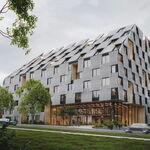Also, I think you meant to say "you are NOT convinced".
Correct, I have edited my post accordingly.
It is one data point of many we should consider. Again, I'll state I am surprised a TMU student project is the only one that is trying to tackle mode-shift surveys, though imperfect.
I await the perfect stat sig study on mode-shift behaviors presented by any data/policy wonk here with bated breath.
There are lots of studies which look into modal split, on a recurrent basis, the corden count here in the GTA being notable among them.
There are reams of hard data available on ridership volumes in transit, number of users of the 407 ETR, parking occupancy rates, City cycling has counters for cyclists too.
Now, not all of that data is demographically granular (though some is).
If you're looking for studies that imply cause and effect, I think that's interesting, but even this one isn't very good at that, because at least among the graphics I saw, it didn't ask for a self-report reason for any shift.
So we don't know about service quality for transit, cost for transit, cost of parking, cost of gas, etc etc.
Overall, I am interested in the default behaviors across the population on where they tend to shift when public transit is unreliable:
View attachment 609206
Second, I am also interested in what mode-shift happens where:
View attachment 609207
This bit is good data, but it also says exactly what I'd expect it too.
Change to active transportation occurs where that infrastructure is best.
Change to transit occurs where service is most frequent.
Change to cars occurs where transit service is poorest, and where cycling infrastructure is poorer; but also where employment uses are generally lower, and therefore commutes longer.
But it is always much easier to critique work than to actually do it.
Putting aside that I 'do' a great deal.............
I would argue thoughtful critiques aren't all that common. Most people either take data they like as true and dismiss data they don't like as fake or misleading; or if open minded they take the data on its face, whatever it says, because they aren't even remotely curious as to how research methodology influenced what data was collected, what questions were asked, how the data was interpreted and what conclusions were drawn.
I'm not relentlessly critical, I am, however a well informed cynic that check's everyone's work.........(sometimes to the annoyance of people on either side of any given debate) . And I don't mind mine being similarly tested.
****
Finally, with any research, I want to know what is actionable as a result.
I'm remarkably disinterested in useless information.
Whatever one is discussing, be it violent crime rates, or recidivism, addiction rates and treatment effectiveness, the life expectancy of people with CF; or those who get Breast Cancer, or the modal split of commuters in Toronto......... I want to know why the question was asked, and what use the data is telling us how we can do something better than we were.
In this case, beyond reinforcing the obvious, that bad transit results in lower ridership, and that good cycling infrastructure results in higher levels of cycling........I'm not sure this project is all that insightful.
I'm not picking on the author(s). Its an interesting subject and student time and resources are limited. Still, I don't see much that's helpful in the data.





